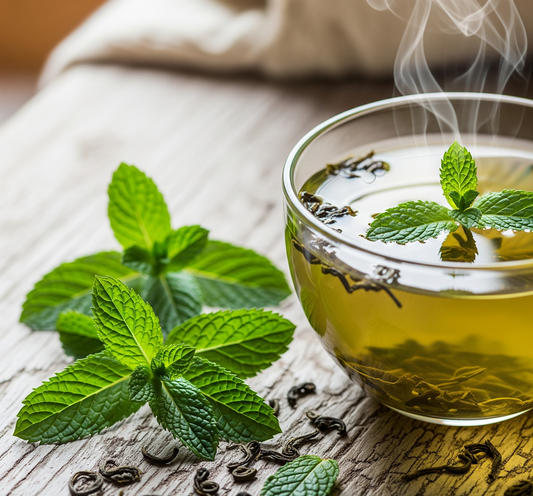Tea aficionados often find themselves exploring the vast and diverse world of teas, encountering terms like first flush and second flush. But what do these terms really mean, and how do they impact the flavor and characteristics of the tea? In this article, we explore the intriguing differences between first flush and second flush teas, shedding light on these distinct harvest seasons and the unique experiences they offer to tea enthusiasts.
First Flush Tea: The Delicate Awakening
First flush tea, also known as spring tea, represents the initial harvest of the tea-growing season. This harvest occurs during the early spring months when tea plants awaken from their winter dormancy. The leaves, having enjoyed a period of rest, flourish with a delicate and vibrant quality. This freshness is reflected in the flavor profile of first flush teas, which often exhibit light, floral notes and a gentle astringency. The liquor appears pale and bright, capturing the essence of the tea plant's rejuvenation.
 The first flush is particularly prized among connoisseurs for its fresh and nuanced flavors, making it one of the most sought-after seasonal teas. Tea gardens carefully pluck the youngest, most tender leaves and buds, ensuring that the tea retains its signature briskness and floral complexity.
The first flush is particularly prized among connoisseurs for its fresh and nuanced flavors, making it one of the most sought-after seasonal teas. Tea gardens carefully pluck the youngest, most tender leaves and buds, ensuring that the tea retains its signature briskness and floral complexity.
You can get our superior First Flush Black Tea Here.
Second Flush Tea: The Mature Complexity
Second flush tea, also referred to as summer tea, follows the first flush and occurs during the summer months. By this time, the tea leaves have undergone further growth and maturation, resulting in a richer and more complex character. The flavor profile of second flush teas tends to be fuller, with a balanced combination of fruity, muscatel, and sometimes even chocolaty undertones. The liquor takes on a deeper hue, ranging from amber to copper, inviting tea lovers to indulge in its warm and robust flavors.
Among tea enthusiasts, second flush Darjeeling tea is particularly famous for its muscatel flavor; a naturally sweet, grape-like note that develops due to the unique climatic conditions of the region. This characteristic makes second flush teas highly popular for those who enjoy a stronger, more rounded taste in their cup.
Here is a blog about Muscatel Teas and its Unique Characteristics.
Terroir's Influence: Unique Flavors from Different Origins
The distinction between first flush and second flush teas is not solely determined by timing; it is also influenced by the unique terroir of tea-growing regions. Different geographic locations contribute their own natural elements, including soil composition, elevation, and climate, which impact the flavor development of the teas.
 For example, First Flush Darjeeling teas from India are celebrated for their delicate floral notes, while Second Flush Darjeeling teas offer more pronounced muscatel flavors. Similarly, Nepali first flush teas exhibit bright and aromatic characteristics, while second flush teas deliver a fuller body with notes of stone fruit. The variation in terroir ensures that no two batches of first or second flush teas are exactly alike, adding to their allure.
For example, First Flush Darjeeling teas from India are celebrated for their delicate floral notes, while Second Flush Darjeeling teas offer more pronounced muscatel flavors. Similarly, Nepali first flush teas exhibit bright and aromatic characteristics, while second flush teas deliver a fuller body with notes of stone fruit. The variation in terroir ensures that no two batches of first or second flush teas are exactly alike, adding to their allure.
Harvest Time, Harvest Techniques: How It Affects the Tea
The timing of the harvest plays a crucial role in the flavor profiles of first flush and second flush teas. During the first flush, pluckers selectively gather the tender young leaves and buds, which have absorbed the fresh energy of the early spring. In contrast, second flush teas are harvested slightly later, allowing the leaves to mature further and develop a unique complexity. The skillful art of plucking and processing, carried out by experienced tea artisans, ensures that the inherent qualities of each flush are skillfully preserved.
The oxidation and rolling process also differs between flushes. First flush teas typically undergo minimal oxidation to maintain their delicate, fresh flavors, while second flush teas are often allowed to oxidize longer, enhancing their depth and boldness.
First Flush vs. Second Flush Tea: Which One Should You Choose?
Ultimately, the choice between first flush and second flush teas comes down to personal preference. Some tea enthusiasts prefer the delicate and refreshing nature of first flush teas, while others relish the deeper and more nuanced flavors of second flush teas. Brewing techniques, such as water temperature, steeping time, and the use of different teaware, can also influence the extraction of flavors, allowing tea lovers to tailor their experience to their liking.
If you enjoy light, floral, and slightly astringent flavors, first flush tea is your ideal choice. However, if you prefer a bolder, fruitier, and more full-bodied tea, second flush tea will be a more satisfying option. Experimenting with both flushes can provide a well-rounded appreciation of the different flavor profiles tea has to offer.
You can get our superior First Flush Black Tea Here.
Conclusion
First flush and second flush teas represent two distinct stages in the tea-growing season, each offering a captivating journey of flavors and aromas. Whether it's the delicate awakening of first flush or the mature complexity of second flush, tea lovers have the opportunity to explore the diverse spectrum of tea experiences. Embracing the unique characteristics of each flush allows us to savor the rich tapestry of flavors that the world of tea has to offer. So, go ahead and embark on a delightful tea adventure
FAQ’s about First Flush and Second Flush Tea
First flush vs second flush tea: which is better?
There is no definitive answer, as it depends on individual preferences. First flush teas are lighter, floral, and delicate, while second flush teas are more robust, fruity, and full-bodied. Both have unique characteristics that make them special.
Darjeeling first flush vs second flush: What’s the difference?
Darjeeling first flush teas are known for their bright, floral, and slightly astringent qualities, whereas Darjeeling second flush teas are famous for their muscatel flavor, a naturally sweet and wine-like taste that develops in the summer harvest.
Should I choose Darjeeling tea first or second flush?
If you prefer a lighter, more floral tea, go for the first flush. If you enjoy a deeper, more complex flavor with fruity undertones, the second flush is the better choice.
What makes second flush tea unique?
Second flush tea stands out due to its richer, more mature flavor profile, deeper liquor color, and the presence of muscatel and fruity notes, especially in teas from Darjeeling and Nepal.
About the Author
Nishchal Banskota is the founder of Nepal Tea Collective, dedicated to offering the finest Nepali teas. With years of experience in the tea industry, Nishchal is passionate about sharing the culture and craftsmanship of Nepali tea with the global tea industry. Learn more about Nepal Tea Collective and explore a variety of award-winning teas that bring you closer to the heart of Nepal.




